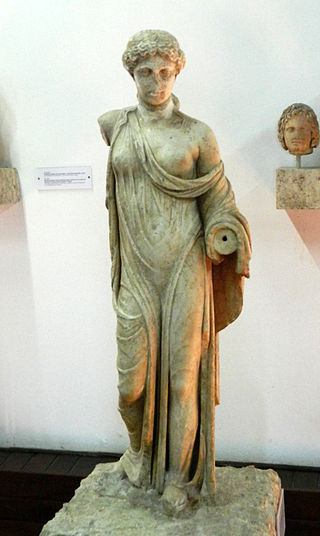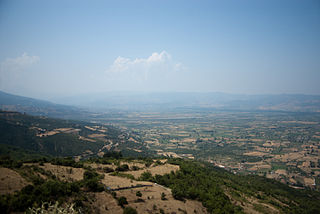
Eretria is a town in Euboea, Greece, facing the coast of Attica across the narrow South Euboean Gulf. It was an important Greek polis in the 6th and 5th century BC, mentioned by many famous writers and actively involved in significant historical events.

Akanthos was an ancient Greek city on the Athos peninsula, on the narrow neck of land between the sacred mountain and the mainland, to the northwest of the Xerxes Canal. It was founded in the 7th century BCE as a colony of Andros, itself a colony of Chalcis in Euboea. Chalcidice was multi-cultural. The archaeology of the region suggests that some Hellenes were already there. The site is on the north-east side of Akti, on the most eastern peninsula of Chalcidice.

The Archaeological Museum of Corfu in Corfu, Greece was built between 1962 and 1965. The museum land was donated by the city of Corfu. Its initial purpose was to house the archaeological finds from the Temple of Artemis in Corfu. In 1994 it was expanded with the addition of two more exhibit halls that display the more recent finds at the ancient citadel of Corfu. It is located on 1 Vraila Armeni St.

Delphi Archaeological museum is one of the principal museums of Greece and one of the most visited. It is operated by the Greek Ministry of Culture. Founded in 1903, it has been rearranged several times and houses the discoveries made at the Panhellenic sanctuary of Delphi, which date from the Late Helladic (Mycenean) period to the early Byzantine era.
The Spartia temple is an ancient Greek cult site excavated at the foot of the hill of Spartia, north of the village of Sesklo, in the Magnesia regional unit. An inscribed dedication suggests the worship there of the Greek mythological figures Heracles and Alcmene.
The Ephorate of Underwater Antiquities is a department within the Greek Ministry of Culture responsible for underwater archaeology.

The Archaeological Museum of Ancient Corinth was constructed between 1931 and 1932, with intentions to display the numerous recent archaeological excavations. The museum is located within the archaeological site of Ancient Corinth, Greece, and lies under the jurisdiction of the 37th Ephoreia of the Greek Archaeological Service.

The Archaeological Museum of Eretria is a museum in Eretria, in the Euboea regional unit of Central Greece.

The Archaeological Museum of Lamia is a museum within the archaeological site of Lamia Castle in Lamia, Greece. The museum is housed in a refurbished barracks built in 1830 by King Otto of Greece. It presents prehistoric and Classical antiquities, covering the Neolithic era, Helladic period, Early Iron Age, Archaic, Classical and Hellenistic periods.
Panagiotis V. Faklaris is a Greek archaeologist, professor of classical archaeology and excavator of the acropolis and the walls of Vergina. Main fields of specialization: topography of ancient Macedonia, topography of ancient Kynouria, arms and armour, horse harnesses, ancient Greek daily life, metal finds, Greek mythology. Studied archaeology at the Aristotle University of Thessaloniki and the University of Cambridge UK. Born in Arcadia, Greece, April 1947. Assistant (1978–1992) of the famous Greek archaeology professor Manolis Andronikos. Member of the Athens Archaeological Society since 1986. Member of the Greek Folklore Society since 1977. Founding member of the Association for the Study of Ancient Greek Technology (EMAET).EMAET Member of the Historical and Epigraphical Studies Society. Member of the Peloponnesian Studies Society. Εταιρεία Πελοποννησιακών Σπουδών Founding member of the Arcadian Academy.

Ainis or Aeniania, was a region of ancient Greece located near Lamia in modern Central Greece, roughly corresponding to the upper Valley of Spercheios.

This is a reflection of the main historical events in Pieria (Πιερία), Central Macedonia.
The Central Archaeological Council and Museums Council, commonly known simply by its older abbreviation KAS (Κ.Α.Σ.), is the supreme advisory body for all matters pertaining to the "protection of antiquities and cultural patrimony in general" in Greece.

Peirasia or Peiresia, was an ancient Greek polis (city-state), located in the tetrad of Thessaliotis in western Thessaly, close to the confluences of Apidanus and Enipeus. In mythological sources, it is often connected with Asterium, the home of Asterion, one of the Argonauts. The site of Peirasia has recently been securely identified with the archaeological remains at Ermitsi in the region of Karditsa.

The archaeological site at Vlochos is located at the northeast corner of the western Thessalian plain, in the regional unit of Karditsa, Greece. The site is centred around the large hill of Strongilovouni south of the modern village, and contains the remains of several urban settlements of Classical Antiquity. The remains cannot be securely identified with any city known from ancient sources, but the size of the settlement indicates that it must have been one of the poleis or city-states of the region.

Evi Touloupa was a Greek archaeologist and Curator of Antiquities of the Acropolis.

The Diachronic Museum of Larisa exhibits findings from the regional districts of Larissa, Trikala and Karditsa.

The Ahmed III Mosque, also known as the Acrocorinth Mosque or the Ahmed Pasha Mosque, is an Ottoman mosque located in the fortress of the Acrocorinth, in the Peloponnese, Greece. Built on the site of an earlier 16th-century mosque, the monument was commissioned by Sultan Ahmed III after the Ottoman reconquest of 1715. It now lies in a mostly ruinous state, abandoned and neglected, however it did undergo some restoration work in 2000.
In Greece, ephor is a title given to the head of an archaeological ephorate, or archaeological unit. Ephors are responsible to the Ministry of Culture and Sports.














